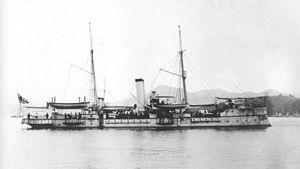Japanese gunboat Akagi

Akagi at Kure in 1902
|
|
| History | |
|---|---|
|
|
|
| Name: | Akagi |
| Ordered: | 1885 |
| Builder: | Onohama Shipyards |
| Laid down: | 20 July 1886 |
| Launched: | 7 August 1888 |
| Commissioned: | 20 August 1890 |
| Struck: | 1 April 1911 |
| Fate: | sold 1912; scrapped 1953 |
| General characteristics | |
| Class and type: | Maya-class gunboat |
| Displacement: | 622 long tons (632 t) |
| Length: | 51.0 m (167.3 ft) |
| Beam: | 8.2 m (26 ft 11 in) |
| Draught: | 2.95 m (9 ft 8 in) |
| Propulsion: |
|
| Speed: | 10.0 knots (11.5 mph; 18.5 km/h) |
| Range: | 74.4 tons coal |
| Complement: | 111 |
| Armament: |
|
| Service record | |
| Operations: | |
Akagi (赤城?) was a steel-hulled, steam gunboat, serving in the early Imperial Japanese Navy. She was the fourth and final vessel to be completed in the four-vessel Maya class and was named after Mount Akagi in Gunma Prefecture.
Akagi was the last in a series of 600-ton gunboats, which included the Maya, Chōkai, and Atago, built from 1885-1886 under the supervisor of the French naval architect, Bellard. She was the only vessel in the class to be equipped with a steel-hull instead of an iron or composite hull.
Akagi was designed with a horizontal double expansion reciprocating steam engine with two cylindrical boilers driving two screws. She also had two masts for a schooner sail rig. Initially, she was required with one Krupp 210 mm (8 in) L/22 breech-loading gun, one Krupp 120 mm (4.7 in) L/22 breech-loading gun and two quadruple 1-inch Nordenfelt guns, and was intended primarily for port defense. However, by early 1894, she had been rebuilt with a high short forecastle and four 120-millimeter guns arranged on her centerline, six 47-mm rapid-fire guns (two by the bridge, facing forward, and two mounted in small sponsons on either side of the hull). All guns were protected by gun shields. Well-armed for her size, she was soon rendered obsolete with the introduction of larger protected cruisers into the Imperial Japanese Navy inventory.
...
Wikipedia
